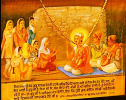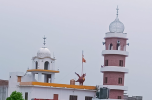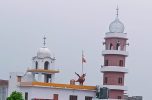dalvinder45
SPNer
- Jul 22, 2023
- 588
- 36
- 79
Guru Nanak Gurdwaras in Gurdaspur District
Dr. Dalvinder Sigh Grewal
Dr. Dalvinder Sigh Grewal
The District of Gurdaspur is situated in Punjab State of Northwestern India surrounded by District Kathua of Jammu and Kashmir State in the North, District Hoshiarpur in the Southeast, Districts Chamba and Kangra of Himachal Pradesh State in the Northeast, District Kapurthala in the South, District Amritsar in the Southwest and Pakistan in the Northwest. . It is 3569 Sq. Km. in area. It is The City of Gurdaspur is the Headquarter of this District.
Gurdaspur was founded in the begining of 17th Century by Guriya ji a resident of Village Paniar situated 5 miles North of Gurdaspur. He purchased land for Gurdaspur from farmers of Sangi Caste. This District is famous for manufacturing Machine tools and Woolen products. It has been divided into 5 Tehsils and 10 Sub-Tehsils – Tehsils – Batala , Dera Baba Nanak , Gurdaspur , Pathankot , Dhar KalanSub-Tehsils – Bamyal , Dhariwal , Kahnuwan , Kalanaur , Narot Jaimal Singh , Qadian , Sri Hargobindpur , Dina Nagar , Naushehra Majha Singh , Fatehgarh Churian.
Gurdaspur has been the key centre of Guru Nanak’s activity once he settled in Kartarpur Sahib which earlier was a part of Gurdaspur district but now is in Pakistan. Area around Pakhoke where Guru’s family had settled and where Guru Nanak meditated have been plaves of pilgrimages. Following Gurdwaras I present Gurdspur District commemorate Guru Nanak’s visit.
- Gurdwara Darbar Saib Dera Baba Nanak , District Gurdaspur
- Dehra Sahib Batala
- Kandh Sahib Batala
- Fallahi Sahib Wadala Granthian
- Gurdwara Achal Sahib District Gurdaspur
- Gurdwara Guru ka Baag, Kathiala, Dera Baba Nanak District Gurdaspur
- Gurdwara, Thada sahib, Kathiala, Dera Baba Nanak , District Gurdaspur
- Gurdwara, Gosht Asthan, Kathiala, Dera Baba Nanak , District Gurdaspur
- Gurdwara Guru Nanak Dev ji, Kiri Afghana, Batala, District Gurdaspur
Dera Baba Nanak is located in Gurdaspur District of Punjab, India. It is 36 km away from Gurdaspur city. 50 kms from Sri Amritsar KM and 30 Kms from Batala.[1][2] Dera Baba Nanak has been visited by Three famous Gurudwaras at Dera Baba Nanak are Sri Darbar Sahi, Sri Chola Sahib [3] [4] and Tahli Sahib (Gurudwara of Baba Sri Chand ji) eldest son of Guru Nanak, the first Sikh Guru. Guru Nanak,[3] the first Sikh Guru settled and is believed to had become one with the Almighty near the village Pakhoke Mehmaran, opposite to the present town and named it Kartarpur - a town which lies over the border in Pakistan.[5] The Bedis (Khatris),[3] descendants of Guru Nanak built a new town and named it Dera Baba Nanak after their ancestor. It is an ancient city of the time of Guru Nanak. \
Dera Baba Nanak being situated only 1 km from India-Pakistan border, Gurdwara Kartarpur Sahib on Pakistan side across Ravi can be seen from the border with naked eyes at a distance of about 4-5 kms from Dera Baba Nanak. Pilgrims come to this holy town in large numbers. Since November 2019, a corridor between India and Pakistan has been established at its shrine. Before the corridor came the pilgrims used to see Gurdwara Darbar Sahib at Kartarpur across the border of Pakistan through telescope. Now the Kartarpur corridor in the area of Dera Baba Nanak has been created for the visitors to go to Kartarpur Sahib and the town forms part of the Kartarpur Corridor.
The town was established later in about 25 acres of land by Baba Manak Chand ji and Baba Mihar Chand ji, grandsons of Baba Lakhmidas ji, on whose names the main markets here are known. After Guru Nanak Dev Ji, Guru Angad Devji, Guru Amardas Ji, Guru Arjan Dev Ji and Guru Hargobind Ji visited this place. Famous Gurudwaras at Dera Baba Nanak are Sri Darbar Sahib,Thada sahib, Sri Chola Sahib[6] and Tahli Sahib (Gurudwara of Baba Sri Chand ji) eldest son of Guru Nanak.[3][6][7] The first Sikh Guru settled and is believed to have joined eternal light with the Almighty" near the village Pakhoke Mehmaran, opposite to the present town and named it Kartarpur - a town which lies over the border in Pakistan.5] Dera Baba Nanak is a tehsil headquarters [3]. The Bedis (Khatris),[3] descendants of Guru Nanak built a new town and named it Dera Baba Nanak after their ancestor. Dera Baba Nanak is a historical town and has many lanes and houses that have been preserved since the time of Guru Nanak.
Gurdwara Darbar Sahib Dera Baba Nanak, District Gurdaspur
Gurudwara Sri Darbar Sahib
Gurudwara Sri Darbar Sahib was built in commemoration of vsit and stay of Guru Nanak in Dera Baba Nanak. He came here after his first Udasi (tour) during December 1515 AD to see members of his family. His wife Mata Sulakkhani [6] and his two sons Sri Chand [7] and Lakhmi Chand had come to stay here in their maternal home at Pakho-Ke-Randhawa [3] [8]near Dera Baba Nanak, where Lala Mool Chand, father–in–law of Guru Nanak, was working as a Patwari.[9] Dera Baba Nanak was made the headquarter of newly created Tehsil of Dera Baba Nanak. Two famous Gurudwaras commemorating Guru Nanak’s visit to the place are Sri Darbar Sahib and Sri Chola Sahib where garment (Chola) of Guru Nanak are preserved at Gurudwara Sri Chola Sahib. Gurudwara Sri Darbar Sahib was built in commemoration of Sri Guru Nanak Dev. Guru Nanak used to meditate on by the well called "Ajita Randhawa da khooh" Guru Ji usd to have discussions with Ajita Randhawa at this place. Guru Nanak spent the last days of his temporal life at Gurdwara Dera Baba Nanak location. Guru Nanak dev Ji used to stay with a Sikh Sadharan who had some thatched hut and in one Guru Nanak Dev Ji used to meditate.[15] Guru Nanak DevJi finally settled at Kartarpur 4 kms from Dera Baba Nanak and later joined the eterenal light.
Sri Guru Arjan Dev Ji came here and did kirtan at time of death of Baba Dharam Chand Ji (Grand Son of Sri Guru Nanak Dev Ji). This place was also visited by Sri Guru Angad Dev Ji, Sri Guru Amar Das Ji and Sri Guru Hargobind Sahib Ji.(12)(13) During the late 1800's, Maharaja Ranjit Singh provided a copper gilded throne to the Gurdwara and got its canopy covered with marble.
The shrine is in the centre of the town and comprises three separate memorials. The well which originally belonged to Bhai Ajita Randhava still exists and is reverently called Sarji Sahib. Pilgrims take home its water in the belief that it possesses curative properties. The second memorial is the "Kirtan Asthan", a rectangular hall, which marks the site where Guru Arjan listened to Kirtan when visiting Dera Baba Nanak to condole the death of Baba Dharam Das. The Guru Granth Sahib is seated in the hall.[10]
Gurdwara Shri Chola Sahib Dera Baba Nanak
Gurdwara Chola Sahib Dera Baba Nanak
The Chola, or the cloak of Baba Nanak, is the holiest relic of the Guru and is preserved in Dera Baba Nanak in Gurdaspur District of the Punjab. This is a cloak which Nanak wore in his life-time and it is considered so sacred that his immediate followers took every care to keep it safe. The regard and reverence rendered to the Chola by the Sikh community is a testimony to the authenticity of the cloak. The Chola was handed down by Nanak himself and has come down to our times in its original condition. It is commonly alleged that verses from different scriptures in different languages are written on the Chola. But this is not true. The verses chosen for writing on the Chola are quotations from the Holy and Quran as revealed by photographs recently taken.
Inner view of sanctum sanctorum Gurdwara Chola Sahib Dera Baba Nanak. At this place Guru Nanak’s robe presented to him in Iraq is preserved. Along with this are the handkerchief embroidered by Bebe Nanaki at the time of Guru Nanak’s marriage, Chaur Sahib received along with Chola Sahib and the Rumala presented by General Hari Singh Nalwa. The Gurdwara has been under the control of Bedi family. [9]
Chola sahib of Guru Nanak Dev Ji
Though Guru Nanak had not visited the place but his belongings are preserved at the place; one of them is Chola Sahib, the most revered among the local Sikhs. Dhanna Singh Chehal in his biography has recorded some details about it .(15) “This Chola Sahib was presented to Guru Nanak during his visit to Iraq which Guru Nanak used to wear in Iraq considering it as a presentation from a devotee attached to God. TheKing of Iraq Lajbarad tried to get the chola back from Guru Nanak but could not get it and became Guru Nanak’s follower when the Guru gave guided him to the true Lord and the path of truth. After returning from Iran Guru Nanak gve this chola to Guru Angad it passed on to Fifth Guru in sequence. When Guru Arjan Dev Ji was getting Saovar at Sri Harmandir Sahib constructed, Tota Ram a resident of village Shahan near Bukhara, who was involved in dirging the sarovar was wounded his foot with the spade with which he was digging. He tore a piece of cloth from his turban and tied his wounded. Guru Arjan Dev Ji asked him to return to his village, rest and get treated as his services have been duly acknolweldged. Tota Ram prayed saying, Guru ji, here I am able to see you daily but when I go home I would not get this opportunity”. Guru Arjan Dev Ji took the Chola Sahib and gave it to him saying, “This Chola belongs to Guru nanak dev Ji. By seeing thi you will have my darshan.” He enquired,” Once I die, how this Chola will be preserved?” Guru Arjan dev Ji said, “You leave it at a proper place and it will be found out with the blessings of Guru Nanak.” Before dying Tota ram kept the Chola in a cave and covered it with a heavy stone. Later a Sikh Qabli Mal had a dream if this Chola. He went to Tots Ram‘s place and found the place where this Chola was kept. He removed the heavy stone after due meditation on Gurus and bani and took out the Chola A Paras stone wa lso found with the Chola which Qabuli Mal kept with him. Qabli Mal Bedi brought this chola on 17 Falgun after it was for 17 years at Tota Ram’s location. This day a large fair is held at gurudwara Chola Sahib. This chola has been preserved by Bedis ever since in a separate gurdwara. Colour of Chola is brown (gora) as that of Guru Nanak. There are two lage roundals one in the front and the other in the back which have astronomical figures in them in number of languages.. The writing is black. The roundels have red outlines. A handkerchief having been embroidered with human figures by Bebe Nanak is attached to it. This handkerchief came to a Bedi from Bebe Nanaki. Front nd back appear to be the same. It colour is also the same as that of Chola. Bedis then ties this handkerchief to the Chola. Chola sahib is open to visitors all the time, hence it has large income.[15]
There are two gurdwaras named Chola Sahib one maintained by SGPC and the other by Bedis. When Akalis took over Gurdwaras, Bedis kept kept Chola sahib with them and made a separate gurdwara. These days Chola Sahib is in this Gurdwara. A large fair is held everyyear on 22, 23 Falgun where large donation s are collected by Bedis.
Gurdwara Chola Sahib
Gurdwara Chola Sahib, in the eastern part of the town, is connected with a relic a chola, or cloak, believed to have been presented to Guru Nanak by a Muslim devotee at Baghdad
Gurdwara Thada Sahib
Gurdwara Thada Sahib is the place where Sri Guru Nanak Dev Ji held a series of important discussions with Baba Ajita Randhawa, after returning from his first preaching tour or Udasi in 1515.
The third memorial is the central shrine, called Thada Sahib. This marks the 'thada' or platform, on which Guru Nanak had sat when he first came to Ajitta's well and later Baba Sri Chand buried his father's ashes. Gurudwara Thada Sahib was constructed where Guru Ji held discussion with Ajita Randhawa. Following this discussion Ajit Randhawa became Guru’s devout follower. After Guru Nanak having joined the eternal light the pot containing Guru’s ashes was buried in Kartarpur Sahib but when the Ravi was flooded Baba Sri Chand took the pot of ashes from there and buried it here at the place now known as Thada Sahib. [7]
The Guru Granth Sahib is seated here in a small square pavilion with a pinnacled lotus dome under an overhanging gilded canopy. The whole pavilion is covered with gold-plated metal sheets with some of the hymns of Guru Nanak embossed on them. The 'Thara sahib' is at one end of a recently constructed spacious hall, above which, over the sanctum, is a square domed room with an ornamental arched coping and domed kiosks at the corners. The entire exterior above the roof level of this room is covered with gold-plated metal sheets. The goldwork on top as well as on the sanctum was got executed in 1827 by Maharaja Ranjit Singh, who also made endowments in cash and land for the maintenance of the shrine. A handwritten copy of the Guru Granth Sahib is preserved in this Gurdwara. It has 1660 pages, each page having a handsomely illuminated border.[7]
The Gurdwara is administered by the Shiromani Gurdwara Parbandhak Committee (SGPC) through a local committee. Special divans take place on every amavasya, the last day of the dark half of the lunar month, and all major anniversaries, especially the one marking the death of Guru Nanak, are observed. But the most important annual event is the fair celebrating the Baisakhi festival. (14)(15)Reference
1. Dera Baba Nanak
2. Dera Baba Nanak Municipal Council City Population Census 2011-2023 | Punjab
3. "Shri Darbar Sahib Dera Baba Nanak". derababananak.com.
4."Kartarpur Sahib Dera Baba Nanak". derababananak.com.
5. Gurdwara Dera Baba Nanak - SikhiWiki, free Sikh encyclopedia.
6. "Gallery Dera Baba nanak". derababananak.com.
7. "Dera Baba Nanak". derababananak.com.
8. "Kartarpur Sahib Dera Baba Nanak". derababananak.com.
9 Punitinder Kaur Sidhu, Gurdwara Darbar Saib Dera Baba Nanak , District Gurdaspur,Guru Nanak’s Blessed Trail (Punjab), Lonely Planet Global Limited, Punjab October 2019, p.87
10. "Chola Sahib Dera Baba Nanak". derababananak.com.
11. https://www.nativeplanet.com/gurdaspur/attractions/thada-sahib/#overview
12. www.prakashpurb550.mha.gov.in
13. HistoricalGurudwaras.com, a Journey to Historical Gurudwara Sahibs
14. Gurdwara Dera Baba Nanak - SikhiWiki, free Sikh encyclopedia.
15. Dhanna Singh Chehal,Gur Tirath Cycle Yatra, (20 November 1931) , p. 339
Last edited:







